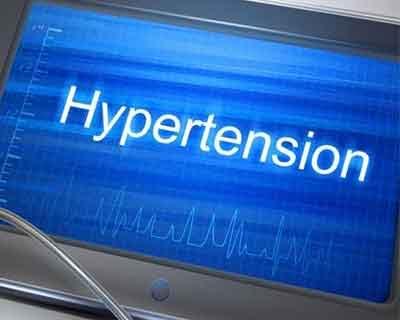- Home
- Editorial
- News
- Practice Guidelines
- Anesthesiology Guidelines
- Cancer Guidelines
- Cardiac Sciences Guidelines
- Critical Care Guidelines
- Dentistry Guidelines
- Dermatology Guidelines
- Diabetes and Endo Guidelines
- Diagnostics Guidelines
- ENT Guidelines
- Featured Practice Guidelines
- Gastroenterology Guidelines
- Geriatrics Guidelines
- Medicine Guidelines
- Nephrology Guidelines
- Neurosciences Guidelines
- Obs and Gynae Guidelines
- Ophthalmology Guidelines
- Orthopaedics Guidelines
- Paediatrics Guidelines
- Psychiatry Guidelines
- Pulmonology Guidelines
- Radiology Guidelines
- Surgery Guidelines
- Urology Guidelines
More individuals may have masked hypertension than is evident : AHA

A new study shows that around the clock monitoring of blood pressure during daily activity revealed masked, or undetected, high blood pressure in a significant number of otherwise healthy adults who had normal readings in the clinic. The findings stem from data of 888 participants at Stony Brook University and Columbia University. Led by Joseph E. Schwartz, PhD, of Stony Brook University, the findings will be published in the American Heart Association's journal Circulation.
The reverse of "white coat hypertension" (higher blood pressure readings at the doctor's office than outside the clinic setting), "masked hypertension" is normal blood pressure in the doctor's office but high readings outside of the office. Masked hypertension is easy to miss, and can occur during the day or night. Masked hypertension is uncovered with 24-hour ambulatory, or around the clock, monitoring. Patients go about their daily activities while wearing a blood pressure cuff on their arm, attached to a small, portable device. Compared to clinic blood pressure, ambulatory blood pressure is known to be a better predictor of future heart disease.
The study results challenge a common belief that ambulatory blood pressure is usually lower than clinic blood pressure, in part because of the so-called "white-coat effect" caused by increased anxiety from clinic testing. The study compared clinic blood pressure measurements to ambulatory blood pressure monitoring in working, middle-aged participants between 2005 and 2012.
They found:
- 15.7 percent of participants with normal clinic blood pressure had masked hypertension based on ambulatory monitoring; this was more common in men than women and in those with prehypertension (also known as borderline hypertension).
- Younger, normal-weight participants were more likely than older, overweight participants to have ambulatory blood pressure readings higher than their clinic readings.
"These findings debunk the widely held belief that ambulatory blood pressure is usually lower than clinic blood pressure," said Dr. Schwartz, lead author, Professor of Psychiatry and Sociology at Stony Brook and Lecturer at Columbia University. "It is important for healthcare providers to know that there is a systematic tendency for ambulatory blood pressure to exceed clinic blood pressure in healthy, untreated individuals evaluated for hypertension during well-patient visits. Our study's results may not apply to those who have previously been diagnosed as having hypertension or are already being treated for hypertension."
Study participants had three blood-pressure readings taken during each of three clinic visits and completed one 24-hour ambulatory blood pressure recording (with readings taken approximately every 30 minutes). None of the participants were taking medication to lower blood pressure. More than half of participants were female, and their average age was 45. Most participants were white, 7 percent were African American, and 12 percent were Hispanic.
Researchers say the study reveals that there are a substantial number of otherwise healthy individuals who have masked hypertension and should have their blood pressure monitored regularly. But they also emphasized that their findings need to be confirmed in further studies with more diverse populations.
You can read the full article by clicking on the link :
Joseph E. Schwartz, Matthew M. Burg, Daichi Shimbo, Joan E. Broderick, Arthur A. Stone, Joji Ishikawa, Richard Sloan, Tyla Yurgel, Steven Grossman, Thomas G. Pickering. Clinic Blood Pressure Underestimates Ambulatory Blood Pressure in an Untreated Employer-Based US PopulationClinical Perspective. Circulation, 2016; 134 (23): 1794 DOI: 10.1161/CIRCULATIONAHA.116.023404

Disclaimer: This site is primarily intended for healthcare professionals. Any content/information on this website does not replace the advice of medical and/or health professionals and should not be construed as medical/diagnostic advice/endorsement or prescription. Use of this site is subject to our terms of use, privacy policy, advertisement policy. © 2020 Minerva Medical Treatment Pvt Ltd